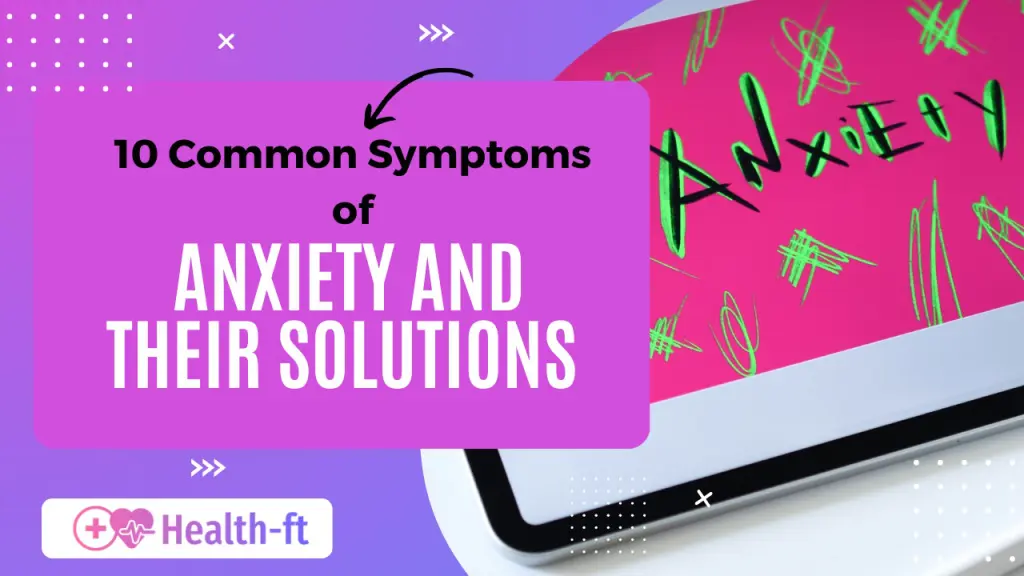A
nxiety is one of the most prevalent mental health conditions globally, affecting approximately 264 million people, according to the World Health Organization (WHO). While anxiety can be a normal stress response, it can become debilitating when persistent and overwhelming. Anxiety manifests in diverse ways, including physical symptoms of anxiety disorders, such as muscle tension, gastrointestinal problems, and symptoms of breath holding anxiety, making it essential to understand its symptoms and solutions for effective management.This comprehensive guide explores 10 common symptoms of anxiety and their solutions to help alleviate its impact. Whether you experience occasional bouts of anxiety or deal with severe anxiety symptoms, these insights aim to improve your quality of life.
1. Excessive Worrying
Symptom:
Anxiety often leads to persistent and uncontrollable worrying about future events or perceived dangers, causing mental and emotional strain. This symptom can persist for varying durations, prompting many to wonder, how long do symptoms of anxiety last? Additionally, symptoms of childhood anxiety disorder often include excessive worrying, which can manifest in academic, social, or family settings.
Solution:
- Cognitive Behavioral Therapy (CBT): Restructure negative thought patterns into more realistic ones.
- Mindfulness Meditation: Practice staying present to reduce overthinking about future uncertainties.
- Learn about embracing a healthy lifestyle with daily habits to support mental well-being
2. Restlessness
Symptom:
Symptom: Restlessness is marked by the inability to relax or sit still, often exacerbated by weird physical symptoms of anxiety such as trembling or tingling sensations. It may also involve symptoms of breath holding anxiety, where shallow breathing creates further distress.
Solution:
- Engage in regular physical activity to release nervous energy and promote relaxation.
- Breathing Techniques: Focus on deep breathing exercises and controlled breathing to combat shortness of breath caused by anxiety.
3. Fatigue
Symptom:
Anxiety-related fatigue is distinct from regular tiredness, often stemming from mental strain and disrupted sleep. This symptom can appear alongside signs and symptoms of anxiety in women, particularly those associated with hormonal changes like hormone anxiety disorder.
Solution:
- Prioritize sleep hygiene: maintain a consistent sleep schedule and minimize screen time before bed.
- Incorporate relaxation techniques like rhythmic breathing and guided imagery.
4. Difficulty Concentrating
Symptom:
Intrusive thoughts and excessive worry hinder focus and productivity, a common issue in both anxiety and depression. This overlap highlights the connection between symptoms of anxiety and depression, which often occur together and exacerbate cognitive difficulties.
Solution:
- Use deep breathing techniques to calm your mind and enhance concentration.
- Break tasks into manageable segments to reduce overwhelm and increase efficiency.
5. Sleep Disturbances
Symptom:
Anxiety often leads to insomnia or disrupted sleep, compounding fatigue and irritability. Chronic lack of sleep can amplify weird physical symptoms of anxiety, such as dizziness or tingling sensations.
Solution:
- Maintain a consistent bedtime routine.
- Avoid caffeine and limit screen exposure before sleep to support melatonin production.
6. Panic Attacks
Symptom:
Panic attacks are intense bouts of anxiety with symptoms such as chest pain, crying, and shortness of breath. It’s often difficult to differentiate between symptoms of a heart attack vs anxiety, creating confusion and additional fear. For some, these episodes are accompanied by symptoms of anxiety attack crying, where overwhelming emotions lead to tears.
Solution:
- Practice grounding techniques like the “5-4-3-2-1” method to focus on the present moment.
- Seek guidance from a therapist for tailored strategies to manage symptoms of anxiety and panic attacks effectively.
7. Muscle Tension
Symptom:
Persistent muscle tension can cause discomfort and physical strain, often contributing to severe anxiety symptoms like jaw clenching or back pain.
Solution:
- Engage in stretching exercises or Pilates to ease tension.
- Consider massage therapy to relax stiff muscles
8. Social Withdrawal
Symptom:
Anxiety can lead to social isolation, worsening symptoms of anxiety and depression and reducing one’s ability to reintegrate into social settings.
Solution:
- Gradually expose yourself to social settings to build confidence.
- Join support groups to connect with others who share similar experiences.
9. Increased Heart Rate
Symptom:
Anxiety-induced palpitations or arrhythmias can mimic symptoms of a heart attack vs anxiety, creating additional fear. These episodes may be linked to the causes of anxiety attacks and panic attacks, such as heightened stress or traumatic events.
Solution:
- Practice diaphragmatic breathing or the 4-7-8 technique to lower heart rate.
- Regular breathing exercise supports cardiovascular health and reduces anxiety symptoms.
10. Gastrointestinal Issues
Symptom:
Anxiety often disrupts digestion, leading to nausea, bloating, or IBS. This highlights the connection between the gut and brain, where stress impacts digestion and vice versa. Chronic cases may stem from causes of anxiety attacks and panic attacks or co-occurring mental health conditions.
Solution:
- Follow a balanced diet and avoid trigger foods.
- Explore alternative treatments for anxiety and depression, such as dietary changes, mindfulness practices, and strategic stress management techniques.
Managing Anxiety: The Way Forward
Anxiety manifests in various forms, from physical symptoms of anxiety disorders to emotional challenges like symptoms of anxiety attacks and crying. For those dealing with persistent or severe symptoms, exploring alternative treatments for anxiety and depression—such as mindfulness, exercise, or therapy—can be transformative.
Understanding the causes of anxiety attacks and panic attacks and addressing them early is essential for improving mental health. If anxiety disrupts daily life or prevents normal functioning, seeking professional help is highly recommended. By recognizing symptoms of anxiety and panic attacks and managing them effectively, it’s possible to regain control and work towards a balanced and fulfilling life.
FAQS
How might one be able to overcome or at least minimize anxiety?
Managing anxiety very much involves taking care of the self, counseling, and even prescription to take some medication. CBT, exercise regimen, mindfulness, and good nutrition are among the approaches known to eliminate anxiety disorders.
What can I do to avoid having panic attack?
It is therefore effectively to manage general anxiety and through practices such as relaxation, stress management as well as seeking professional help where necessary to avoid having a panic attack. Knowing grounding techniques and cognitive-behavioral strategies can assist you to prevent having to fend off a panic attack more proficiently when one manifests itself.
When do I need to go for professional help because of anxiety?
When anxiety is impacting upon your ability to function normally, is causing considerable distress or when self help is not beneficial, the assistance of a mental health worker should be sought. It is considerably important to note that anxiety is better addressed if it is treated at an early stage as this will enhance long term prognosis.




